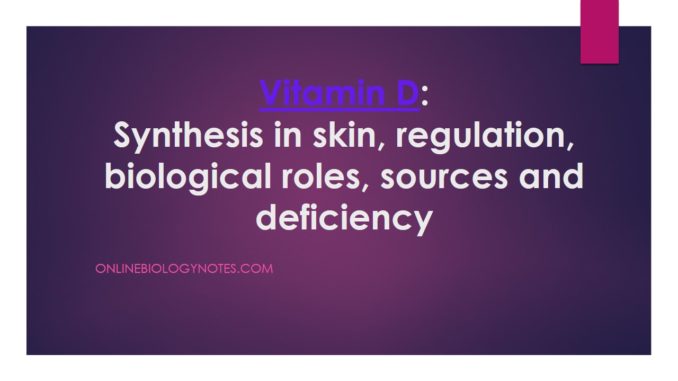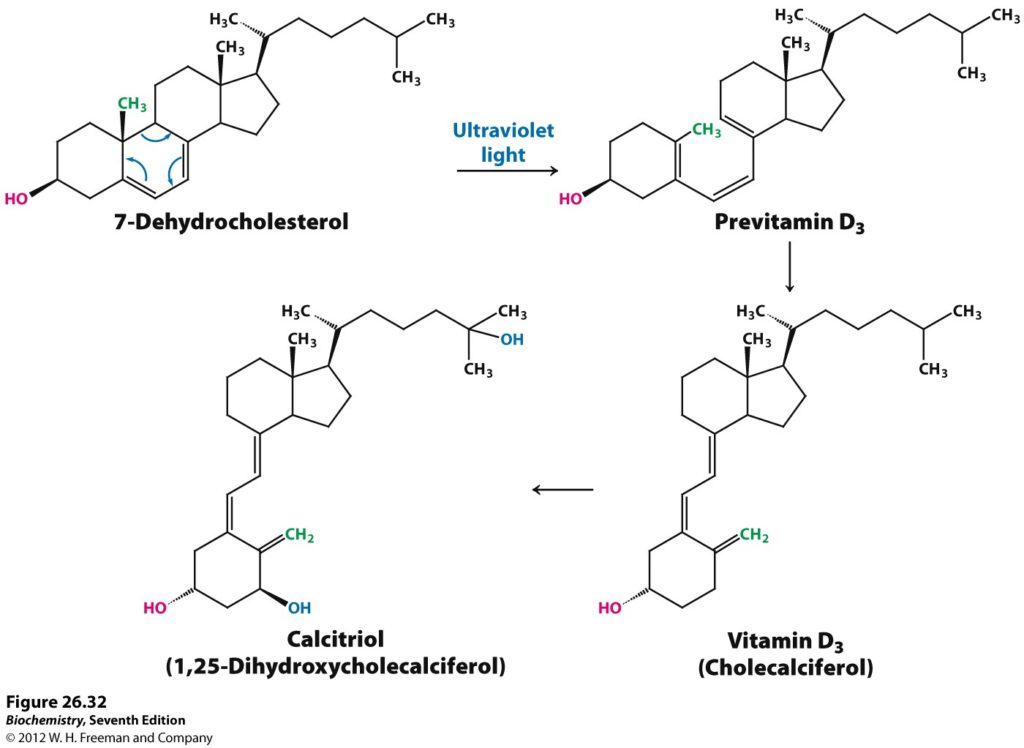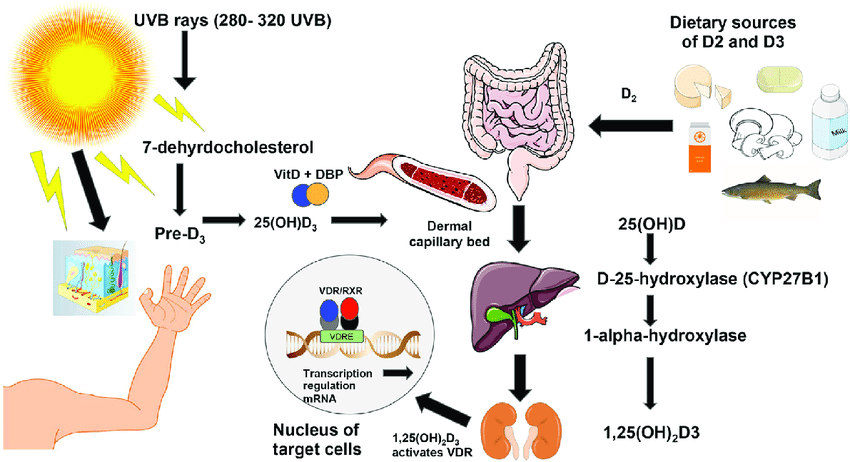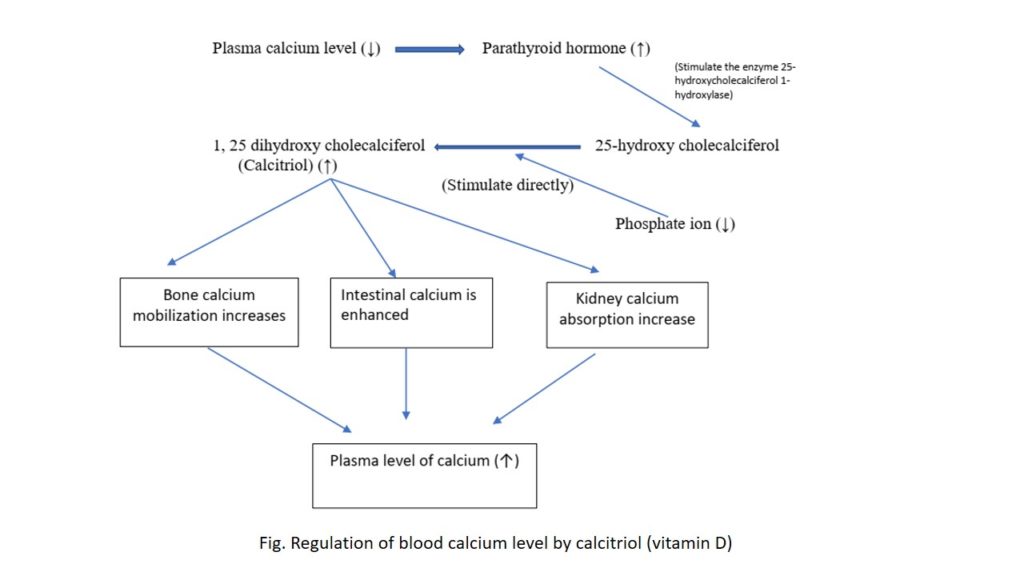
- Vitamin D is another fat-soluble vitamin.
- It has sterol like structure and therefore function like steroid hormones.
- 7-dehydrocholesterol is the animal source of Vit-D which upon exposure to sunlight is converted to cholecalciferol.
- Ergosterol is the plant source of Vit-D which upon exposure to sunlight is converted to ergocalciferol (Vit-D2)
- Main site of activity of Vit D resides in gastrointestinal tract, bone and kidney.
- Properties of Vitamin D:
- Vitamin D is a white and almost odourless crystalline substance.
- It is soluble in fat and fat solvents.
- It is fairly heat resistant and also relatively resistant to oxidation.
- It is not affected by acids and alkalies.
Synthesis of Vitamin D in Skin, transport and metabolism:


Transport and metabolism of calcitriol:
- The active form of Vit-D is calcitriol (1,25-dihydroxy cholecalciferol).
- The liver enzyme cholecalciferol-25-hydroxylase synthesize 25-hydrocholecalciferol from cholecalciferol.
- 25-hydrocholecalciferol is also termed as Calcidiol.
- Placenta also consists of the enzyme 25-hydroxycholecalciferol-1-hydroxylase.
- In kidney, when calcitriol is adequate, an enzyme 24-hydroxylase stores calcitriol in the form of 24,25-dihydroxy cholecalciferol.
- 24,25- dihydroxycholecalciferol also significantly contribute to maintain phosphorus and calcium homeostasis.
Regulation of blood calcium level by calcitriol:
- Plasma level of calcium and phosphorus regulate the activity of calcitriol formation which in turn maintains the calcium level of plasma.

Biological role of Vitamin D:
- The major function of vitamin D is to maintain the plasma level of calcium and phosphorus.
- Calcitriol functions by acting on three major sites:
i. Action in intestine:
- Vitamin D (Calcitriol) stimulate the calcium absorption in the intestine.
- Calcitriol in intestinal cells bind to the calcitriol receptor forming calcitriol receptor complex.
- This calcitriol acts on nucleus stimulating the DNA to produce mRNA and therefore protein called calcium binding protein.
- This calcium binding protein binds and absorbs the calcium.
ii. Action in bone:
- Calcium is very essential for bone formation.
- Calcitriol stimulates calcium absorption and deposition as calcium phosphate.
- Calcium along with parathyroid hormone mobilizes the calcium and phosphate from bone.
iii. Action in kidney:
- Calcitriol along with parathyroid hormone inhibits the calcium excretion from kidney, meanwhile, calcitriol also stimulates the reabsorption of calcium from renal tubules.
Steroid hormone like activity of Vitamin D:
- Vitamin D acts like a steroid hormone, calcitriol stimulates DNA and synthesizes calcium binding protein is intestinal cells.
- Similar to hormones, Vitamin D has short half-life of about 10 hours.
- Biologically active form of vitamin D calcitriol, like steroid hormones is synthesized in kidney.
- Calcitriol is synthesized in skin upon exposure to sunlight.
- Vitamin-D acts along with other hormones like parathyroid hormone and calcitonin to regulate the plasma level of calcium.
- Vitamin-D acts on DNA and is associated with the activation of transcription. This can be justified in a fact that vitamin D is inhibited by actinomycin D. Actinomycin D inhibits initiation of transcription.
- Vitamin D, like hormones have specific organs of action. They act on bone, kidney and intestine.
- Vitamin D (calcitriol) synthesis is subjected to feedback control mechanism like hormones. Calcitriol decreases its own synthesis.
RDA of vitamin D:
- The recommended dietary allowance (RDA) varies from 5 μg/day (in countries with high exposure to sunlight) to 10 μg/day.
Dietary sources of vitamin D:
- Fatty fish, fish liver oil, egg yolk
- vitamin D is also obtained by consumption of irradiated food (irradiated yeast) and exposure to sunlight.
Vitamin D deficiency:
- Vitamin D deficiency occur due to inadequate exposure to sunlight and inadequate consumption of Vitamin D diet.
- Vitamin D deficiency occurs in strict vegetarians, chronic alcoholic, liver and kidney disease and mal-absorption.
- Deficiency results in rickets in children, a condition that is characterized by incomplete mineralization that result in soft and pliable bone and delay in teeth formation.
- In adults deficiency leads to osteomalacia, a condition involving softening of bone.
- This results from bone demineralization.
- Bones are highly susceptible for fracture.
- Renal rickets can occur in individual with renal failure due to decreased synthesis of calcitriol.
Hypervitaminosis D:
- Excessive vitamin D at more than rate 100 times required RDA results in hypervitaminosis of Vitamin D.
- Excessive vitamin D can result in nausea, loss of appetite, loss of body weight.
